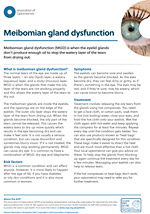Meibomian gland dysfunction
MGD occurs when the glands don’t produce enough oil to stop the watery layer of the tears from drying out
What is meibomian gland dysfunction (MGD)?
The normal tears of the eye are made up of three layers – an oily (lipid) layer, a watery (aqueous) layer, and a sticky (mucous) layer. MGD is when the glands that make the oily layer of the tears are not working properly and this allows the watery layer of the tears to dry out.
The meibomian glands are inside the eyelids, and the openings are on the edge of the eyelids. The outer oily layer stops the watery layer of the tears from drying out. When the glands become blocked, the oily part of the tears cannot be released. This causes the watery tears to dry up more quickly which results in the eye becoming dry and can make it feel sore. It is not usually a serious condition, but can cause discomfort and sometimes blurry vision. If it is not treated, the glands may stop working permanently.
MGD can cause dry eye. It is common to have a combination of MGD, dry eye and blepharitis.
Risk factors
MGD is a common condition and can affect anyone. However, it is more likely to happen after the age of 50, if you have diabetes or oily skin conditions and it is also more common in women.
Symptoms
The eyelids can become sore and swollen as the glands become blocked. As the eyes become dry, they can feel itchy or gritty, as if there’s something in the eye. The eyes may be red, and if they’re sore, may be watery, which can cause vision to become blurry.
Treatment
Treatment involves releasing the oily tears from the glands using hot compresses. You need to get a face cloth, or cotton pads, soak them in hot (not boiling) water, close your eyes, and hold the hot cloth onto your eyelids. Wet the cloth again with hot water and keep applying the compress for at least five minutes. Repeat every day until the condition gets better. You can also use products known as ‘heat bags’ that are specifically designed for this condition. These bags make it easier to direct the heat and are much more effective than a hot cloth. Your local optometrist can give you advice on these. To help stop the glands from blocking up again continue the treatment every day for a few minutes. Massaging your eyelids can also help to release tears.
If the hot compresses or heat bags don’t work, your optometrist may need to refer you for further treatment.
Resources for your practice
 You can download our patient leaflet on MGD.
You can download our patient leaflet on MGD.
If you're a practitioner, we recommend that you use this information, following a suitable examination, to reinforce advice given to the patient who has symptoms of MGD.
For more information on eye health and eye conditions, explore our For patients section.

